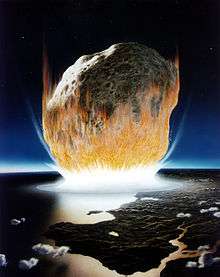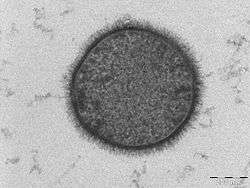Impact survival
Impact survival is a theory that life, usually in the form of microbial bacteria, can survive under the extreme conditions they are exposed to during a major impact event, such as a meteorite striking the surface of a planet.[1] This step is a necessity for the possibility of panspermia, for the microbial life must be able to survive both the escape out of the initial planetary atmosphere, likely due to a major impact, as well the reentry and collision with a second planetary body.

Dangers to life
For small organisms to leave a planet's orbit, escape velocity must be reached, which is dependent upon the mass of the planet. To reach these velocities, both the surviving organisms and the pieces of debris that they live on must withstand large amounts of acceleration and jerk.[2] One calculation has determined that for possible organisms to be launched out of an orbit of a planet the size of Mars, jerk would be nearly 6x109 m/s3.[3] In addition to this, the velocity of incoming meteorites are projected to be in the range of 20 to 25 km/s.[4] Thus any organisms that could survive a major impact event and be sent to outer space must be very small, light, and able to withstand large amounts of acceleration and jerk. While concerns over the heat of ejected rocks and the possible sterilizing affects it would have on the microbial life attached, it has been theorized that for rocks even less than 2 kilograms such as ALH84001, internal parts may never reach temperatures greater than 40 °C.[5]
Possible organisms on Earth

Recent experiments have found organisms that can survive both the acceleration and jerk involved in reaching escape velocity. A major impact event was simulated using an air cannon to propel both ice and agar projectiles covered with chosen microorganisms to extreme speeds and then crashing the projectiles into a solid surface.[2] Two species of bacteria were tested - R. erythropolis and B. subtilis - and while survival rates were low, at 100 GPa of peak pressure there was still a survival rate of 3.9x10−5 in the B. subtilis.[2] These findings have been replicated with other bacteria as well - D. radiodurans[6] as well as when shot into liquid water - with similar low, but not zero, survival rates. Also, experimental methods have been varied, and survival rates have also been found when bacteria are subjected to acceleration at an extended time, through the use of a centrifuge[6] as well as when shot into liquid water.[7] While very small, these finite results show that some lifeforms could survive the impact from a major impact event.
References
- Melosh, H., 1989, Impact Cratering: A Geologic Process, Oxford Univ. Press, Oxford.
- Burchell, M. Survival of bacteria and spores under extreme shock pressures. Monthly Notices of the Royal Astronomical Society, 2004, p. 1277.
- Mastrapa R., Glanzberg h., 2001, Earth Planet. Sci. Lett. 189,1
- Hughes, D. W., and I. P. Williams 2000. The velocity distributions of periodic comets and stream meteoroids. Mon. Not. R. Astron. Soc.315, 629–634
- Weiss, B. P., J. L. Kirschvink, F. J. Baudenbacher, H. Vali, N. T. Peters, F. A. Macdonald, and J. P. Wikswo 2000. A low temperature transfer of ALH84001 from Mars to Earth. Science 290 , 791 – 795
- Mastrapa, R. M. E., H. Glanzberg, J. N. Head, H. J. Melosh, and W. L. Nicholson 2000. Survival of Bacillus subtilis spores and Deinococcus ra-diodurans cells exposed to extreme acceleration and shock predicted during planetary ejection. Lunar Planet. Sci.31, 2045
- D.J. Milner, M.J. Burchell, J.A. Creighton and J. Parnell, Oceanic hypervelocity impact events: a viable mechanism for successful panspermia?, International Journal of Astrobiology, Volume 5, Issue 03, July 2006, pp 261-267